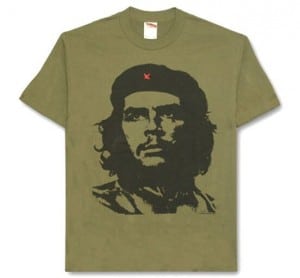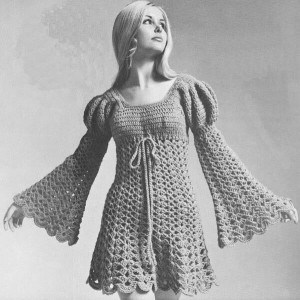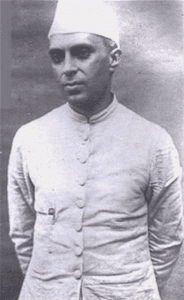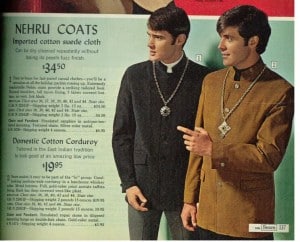Anything Goes: 1960s Clothing
By Alice Askins, Education Coordinator at Rose Hill Mansion
The 1960s emphasized youth and openness. It was a time when many rebelled against established ways. This was expressed in clothing, and, since human culture is a melting pot, anti-fashion became fashionable. Here are a few of the trends of the decade.
Jeans: Jeans were invented by Jacob Davis in 1871 and patented by Davis and Levi Strauss in 1873. Originally designed for cowboys and miners, who needed sturdy fabric and construction, American teenagers began to wear jeans in the 1950s. By the 1960s jeans were everywhere. Middle-class and wealthy young people found them comfortable and functional. Wearing “work pants” also suggested a rejection of bourgeois values and solidarity with the working man. Women were wearing pants more often, and they also took to jeans. The iconic 1960s jeans were bell-bottomed, and they were worn very long. I was one of the many women who wore men’s jeans because they were available in different leg lengths. Since 1960s pants were hip-huggers, the fit of the waist was not an issue. Many people wore older straight-legged jeans with bright patterned gussets inserted in the outer side seams, to make them bell-bottoms.
T-shirts: T-shirts are underwear that became outerwear. The earliest Ts date back to sometime between 1898 and 1913, when the US Navy began issuing them as undergarments. They were crew-necked, short-sleeved, white cotton garments to be worn under uniforms. Servicemen in work parties and tropical climates commonly removed their uniform jackets, wearing (and dirtying) only their undershirts. They would have brought this habit home with them. Civilians, especially boys, started wearing T-shirts for chores and for playing outside. When these boys grew up it was natural to them to continue wearing T-shirts for informal occasions and physical work. The shirts became even more popular in the 1950s after Marlon Brando wore one in A Streetcar Named Desire. In the 1960s, printed T-shirts became as common as jeans. Not only were t-shirts comfortable and informal, they could express your opinions or tell people that you had seen the biggest bands play.
In October 1968, the Geneva paper published an article by a New York writer about appropriate clothing for school.
The annual fracas between school officials and students over classroom attire raged across the land today . . . There was hot and generally unresolved controversy over a number of burning questions . . . On T-shirts, the official rule at Mandan, N. D., High School is: “They’re underwear and not proper school apparel.” But at Radford High School, near Pearl Harbor, Hawaii, T-shirts receive the stamp of approval as long as they do not bear words or pictures.
Comfort and informality prevailed, and T-shirts are still with us.
The past as inspiration: In the mid-1960s there was a “granny dress” trend. Young women wore ankle-length dresses of floral-print cotton, often with mob caps and granny glasses (wire rimmed, with colored lenses, worn low on the nose.) The appeal was the novelty of long skirts when miniskirts were in fashion. My granny dress was light green calico. When the fad was over I cut it short and wore it to school. Women’s dresses and tops also used “historic” sleeve styles – bell sleeves, or puffed sleeves of several types, that evoked the Renaissance.
Young men also looked to history for models. Many dressed as Edwardian dandies with velvet coats, ruffled shirts, flowing ties, and bright colors.
The military: As the decade progressed, people started wearing army surplus clothing. It was inexpensive and well-made. In addition, today’s online forums suggest that to wear an army jacket with a peace symbol (or with long hair and a beard) was to thumb your nose at the war. I wore my father’s army and uncle’s navy WWII jackets and insignia because I thought it was fun, not to make a statement.
India: Our love of the exotic brought us the Nehru jacket. Jawaharlal Nehru, India’s first Prime Minister after independence, didn’t often wear the jacket that bears his name (he preferred a longer version of it, or a western suit). Still, when we thought of India, we thought of him. The interest in Hinduism, Buddhism, and meditation, was accompanied by a liking for the clothing of the subcontinent. In October 1968 the Geneva paper mentioned both men and women wearing Nehru jackets –
Should a girl wear a Nehru jacket with nothing underneath but panties? . . . The boys (in an Arizona district) came to school with short Nehru Jackets, no undershirts and open at the midriff, allowing their navels to show. . . .
It also published a column by a Californian who described buying his first Nehru jacket and wearing it to meditate. I borrowed a bright purple sari with gold embroidery from a Bengali friend, and wore it around one day. That was in 1971, but I would have done the same in the 60s.
India, by the way, is one of the sources of tie dye. The technique was also developed in Africa and Japan.
Africa: The Dashiki is a colorful shirt widely worn in West Africa. A common form of it is a loose pullover with an embroidered or printed V-neckline and sleeves. Dashikis were popular with both men and women in the 1960s. Among African Americans Dashikis were expression of racial pride. The Geneva Times reported in August 1967, that Los Angeles had a new African clothing boutique – .
“Think African,” Rosanna Wright suggests to Negro women coming to her shop. The brightly printed cotton styles will replace the mod look as the latest clothing fad, she predicts. The shop selling “the African look” was opened Tuesday . . . Mrs. Wright wears the loose dress styles patterned after African garb and has had her hair cut in the short style of African women.
White people wore Dashikis, too. In fact, the patterns produced for home-sewn dashikis were often illustrated with blondes.
In the 1960s western culture borrowed from everybody. Native Americans inspired us to wear fringe, beads, and feathers; Latin America lent us ponchos, serapes, and (slightly later) gaucho pants; Europe sent us peasant blouses and dirndl skirts. Nowadays we try to be sensitive to the possibilities of cultural appropriation, and of giving offense, but at that time those ideas had not occurred to most of us. When I wore my friend’s sari, I felt admiration for her and for what I knew of her culture. I enjoyed the beauty of the garment and the novelty of wearing something so different from what I usually wore. (And of course, she would not have asked me if I wanted to borrow it, if the idea had bothered her.) Did you have a favorite garment in the 1960s? Tell us about it!








I wore a green army fatigue shirt over various t-shirts during my college days. I acquired these from the surplus sales at Seneca Army Depot. At the time I thought I was way cool! Who knew that a few months after college graduation I would wear an Army uniform everyday for the next three years.
Were the anti-fashion trends in 1960s clothing a deliberate rebellion against mainstream fashion norms, or did they simply reflect a shift towards more casual and functional attire?”